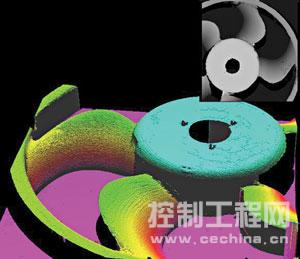The most evident limitation of a two-dimensional vision system is its ability to move and rotate only in the X-Y plane. This has led to a demand for high quality控制工程网版权所有, three-dimensional (3D) processing technologyCONTROL ENGINEERING China版权所有, the use of which is increasing. For engineers exploring the use of 3D inspection控制工程网版权所有, there are now many different technologies available for creating 3D images.
The most important task for engineers to successfully create such an application for industrial use is to achieve a high measurement resolution in all (x, yCONTROL ENGINEERING China版权所有, z) directions. Depending on the shape and size of the object and the distance between the object and the vision sensor, different methods of three-dimensional measurement, and different types of active vision systemsCONTROL ENGINEERING China版权所有, can be used.

A 3D object model

3D image acquisition
The vision system consists of a set of devices, which convert light and measurement data into information, with spatial and material attributes of the scene. These devices have photosensitive sensors (a camera with a lens which focuses images on a photosensitive element or the eye) and computational mechanisms (a computer) allowing information to be collected from the sensors.
Humans can easily distinguish objects they see and are also able to recognize them in various light conditions and from different frames of reference. However控制工程网版权所有, in the case of vision systemsCONTROL ENGINEERING China版权所有, the proper interpretation of a pixel value is a very difficult task. AdditionallyCONTROL ENGINEERING China版权所有, the brightness of pixels (and thus of the image received) depends on several factors:
•Scene geometry - the shape and position of the object in the field of vision (when the shape or the position is cha


 在线会议
在线会议 论坛
论坛 专题
专题 工控直播
工控直播 新闻中心
新闻中心 子站
子站 技术
技术 社区
社区


 剑维软件电子半导体行业白皮书有奖下载
剑维软件电子半导体行业白皮书有奖下载 魏德米勒麒麟系列产品赋能本土工业
魏德米勒麒麟系列产品赋能本土工业 Fluke 283 FC 智能万用表震撼来袭
Fluke 283 FC 智能万用表震撼来袭 SugonRI2.0工业编程平台免费有奖试用
SugonRI2.0工业编程平台免费有奖试用 IDEC HR8S系列新一代安全继电器有奖试用活动
IDEC HR8S系列新一代安全继电器有奖试用活动


























